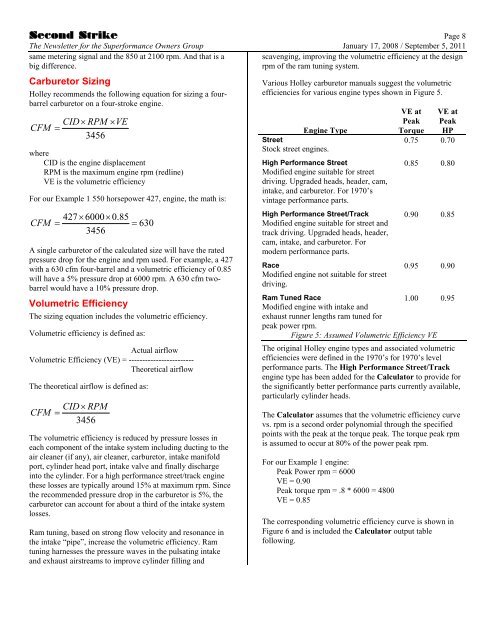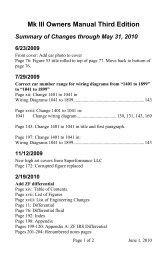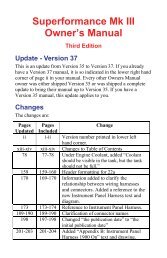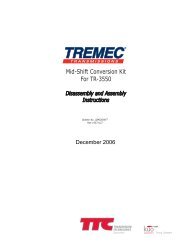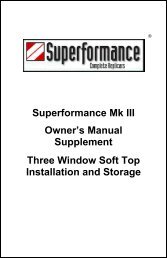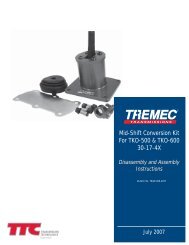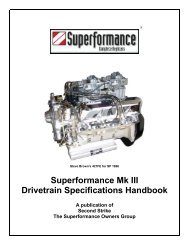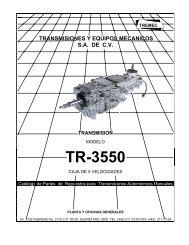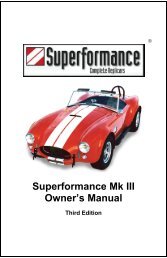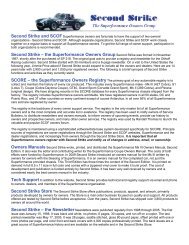Carburetor Calculator - Second Strike
Carburetor Calculator - Second Strike
Carburetor Calculator - Second Strike
Create successful ePaper yourself
Turn your PDF publications into a flip-book with our unique Google optimized e-Paper software.
<strong>Second</strong> <strong>Strike</strong> Page 8<br />
The Newsletter for the Superformance Owners Group January 17, 2008 / September 5, 2011<br />
same metering signal and the 850 at 2100 rpm. And that is a<br />
big difference.<br />
scavenging, improving the volumetric efficiency at the design<br />
rpm of the ram tuning system.<br />
<strong>Carburetor</strong> Sizing<br />
Holley recommends the following equation for sizing a fourbarrel<br />
carburetor on a four-stroke engine.<br />
CID<br />
RPM VE<br />
CFM <br />
3456<br />
where<br />
CID is the engine displacement<br />
RPM is the maximum engine rpm (redline)<br />
VE is the volumetric efficiency<br />
For our Example 1 550 horsepower 427, engine, the math is:<br />
42760000.85<br />
CFM <br />
630<br />
3456<br />
A single carburetor of the calculated size will have the rated<br />
pressure drop for the engine and rpm used. For example, a 427<br />
with a 630 cfm four-barrel and a volumetric efficiency of 0.85<br />
will have a 5% pressure drop at 6000 rpm. A 630 cfm twobarrel<br />
would have a 10% pressure drop.<br />
Volumetric Efficiency<br />
The sizing equation includes the volumetric efficiency.<br />
Volumetric efficiency is defined as:<br />
Actual airflow<br />
Volumetric Efficiency (VE) = ------------------------<br />
Theoretical airflow<br />
The theoretical airflow is defined as:<br />
CID<br />
RPM<br />
CFM <br />
3456<br />
The volumetric efficiency is reduced by pressure losses in<br />
each component of the intake system including ducting to the<br />
air cleaner (if any), air cleaner, carburetor, intake manifold<br />
port, cylinder head port, intake valve and finally discharge<br />
into the cylinder. For a high performance street/track engine<br />
these losses are typically around 15% at maximum rpm. Since<br />
the recommended pressure drop in the carburetor is 5%, the<br />
carburetor can account for about a third of the intake system<br />
losses.<br />
Ram tuning, based on strong flow velocity and resonance in<br />
the intake “pipe”, increase the volumetric efficiency. Ram<br />
tuning harnesses the pressure waves in the pulsating intake<br />
and exhaust airstreams to improve cylinder filling and<br />
Various Holley carburetor manuals suggest the volumetric<br />
efficiencies for various engine types shown in Figure 5.<br />
Engine Type<br />
Street<br />
Stock street engines.<br />
High Performance Street<br />
Modified engine suitable for street<br />
driving. Upgraded heads, header, cam,<br />
intake, and carburetor. For 1970’s<br />
vintage performance parts.<br />
High Performance Street/Track<br />
Modified engine suitable for street and<br />
track driving. Upgraded heads, header,<br />
cam, intake, and carburetor. For<br />
modern performance parts.<br />
Race<br />
Modified engine not suitable for street<br />
driving.<br />
VE at<br />
Peak<br />
Torque<br />
VE at<br />
Peak<br />
HP<br />
0.75 0.70<br />
0.85 0.80<br />
0.90 0.85<br />
0.95 0.90<br />
Ram Tuned Race<br />
1.00 0.95<br />
Modified engine with intake and<br />
exhaust runner lengths ram tuned for<br />
peak power rpm.<br />
Figure 5: Assumed Volumetric Efficiency VE<br />
The original Holley engine types and associated volumetric<br />
efficiencies were defined in the 1970’s for 1970’s level<br />
performance parts. The High Performance Street/Track<br />
engine type has been added for the <strong>Calculator</strong> to provide for<br />
the significantly better performance parts currently available,<br />
particularly cylinder heads.<br />
The <strong>Calculator</strong> assumes that the volumetric efficiency curve<br />
vs. rpm is a second order polynomial through the specified<br />
points with the peak at the torque peak. The torque peak rpm<br />
is assumed to occur at 80% of the power peak rpm.<br />
For our Example 1 engine:<br />
Peak Power rpm = 6000<br />
VE = 0.90<br />
Peak torque rpm = .8 * 6000 = 4800<br />
VE = 0.85<br />
The corresponding volumetric efficiency curve is shown in<br />
Figure 6 and is included the <strong>Calculator</strong> output table<br />
following.


